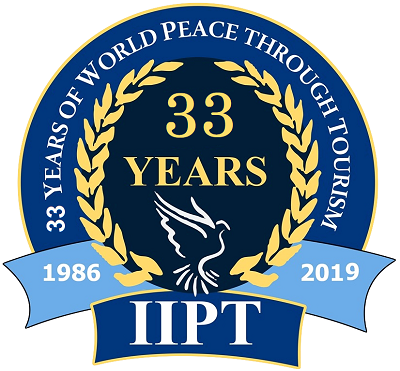The inaugural Peace Park event in this Mexican resort town kicks off at 11:00 AM on the upper level of Los Arcos, the monument located at the entrance of the city. Mayor José Luis Dagnino Lopez of San Felipé will join Bea Broda, an Ambassador of IIPT (The International Institute of Peace through Tourism) to highlight the city’s commitment to peace, and will be joined by women’s dance troupe, Ballet Flor Naranjo, a musician, a poet, and community leaders that will express their excitement for the future of San Felipé.
Capping off the event will be a ceremonial tree planting and placement of a plaque designating San Felipé as a city that will nurture the growth of peace, tolerance and understanding at home and throughout the world, and enhance awareness of a community’s commitment to peace, inclusiveness, a healthy environment and sustainability. It is meant to dedicate a common ground for members of the community to come together in celebration of Mexico’s people, land, and heritage; the future of all humankind, and our common home, planet earth. The San Felipé Los Arcos Peace Park will be a place of reflection on our connectedness to one another as a Global Family and to the earth of which we are all apart.
About the International Institute for Peace through Tourism (IIPT)
The International Institute for Peace through Tourism (IIPT) was born in 1986, the International Year of Peace, with a vision of travel and tourism becoming the world’s first global peace industry and the belief that every traveler is potentially an “Ambassador for Peace.” The IIPT First Global Conference, Tourism: A Vital Force for Peace, Vancouver 1988, with 800 delegates from 68 countries was a transformative event. At a time that most tourism was ‘mass tourism’, the Conference first introduced the concept of ‘Sustainable Tourism’ as well as a new paradigm for a “Higher Purpose” of tourism that gives emphasis to the key role of tourism in fostering travel and tourism initiatives that contribute to international understanding; cooperation among nations; an improved quality of environment; cultural enhancement and the preservation of heritage; poverty reduction; reconciliation and healing wounds of conflicts; and through these initiatives, helping to bring about a peaceful and sustainable world. IIPT has since organized some 20 international conferences and global summits in different regions of the world with a focus on actual case studies that demonstrate and promote these values of tourism.
In 1990, IIPT pioneered the role of tourism in poverty reduction by identifying potential projects in four countries of the Caribbean and three in Central America. Following the U.N. Conference on Environment and Development (Rio Summit in 1992), IIPT developed the world’s first Code of Ethics and Guidelines for Sustainable Tourism and in 1993, conducted the world’s first international study on Codes of Conduct and Best Practices for Tourism and Environment. IIPT’s 1994 Montreal Conference: “Building a Sustainable World through Tourism” was the first major international conference on sustainable tourism. The Conference was instrumental in the World Bank beginning its support for tourism projects aimed at poverty reduction in developing nations. Other development agencies followed and by 2000, tourism’s role in poverty reduction became widely recognized.
In 1992, as part of Canada 125 celebrations commemorating Canada’s 125th birthday as a nation, IIPT conceived and implemented “Peace Parks across Canada.” 350 cities and towns from St. John’s, Newfoundland across five time zones to Victoria, British Columbia, dedicated a park to peace on October 8 as the nation’s Peace Keeping Monument was being unveiled in Ottawa and 5,000 Peace Keepers passing in review. Of the more than 25,000 Canada125 projects, Peace Parks across Canada was said to be the “most significant.” Since then, IIPT international peace parks have been dedicated as a legacy of each or IIPT’s international conferences and global summits. Noteworthy IIPT International Peace Parks are located at: Bethany Beyond the Jordan, site of Christ’s baptism; Victoria Falls, one of the seven natural wonders of the world; Ndola, Zambia, site of U.N. Secretary General Dag Hammarskjold crash en route to a peace mission in the Congo; DMedellin, Colombia, dedicated on Opening Day of the UNWTO 21st General Assembly; Sun River National Park, China; and the Uganda Martyr’s Catholic Shrine, Zambia.
One of IIPT’s current major initiatives is a Global Peace Parks Project with a goal of 2,000 Peace Parks by November 11, 2020 commemorating the Centenary of World War I and its theme “No More War.”
IHE Ị GA-Ewepụ na edemede a:
- Capping off the event will be a ceremonial tree planting and placement of a plaque designating San Felipé as a city that will nurture the growth of peace, tolerance and understanding at home and throughout the world, and enhance awareness of a community's commitment to peace, inclusiveness, a healthy environment and sustainability.
- The International Institute for Peace through Tourism (IIPT) was born in 1986, the International Year of Peace, with a vision of travel and tourism becoming the world's first global peace industry and the belief that every traveler is potentially an “Ambassador for Peace.
- Mayor José Luis Dagnino Lopez of San Felipé will join Bea Broda, an Ambassador of IIPT (The International Institute of Peace through Tourism) to highlight the city's commitment to peace, and will be joined by women's dance troupe, Ballet Flor Naranjo, a musician, a poet, and community leaders that will express their excitement for the future of San Felipé.























